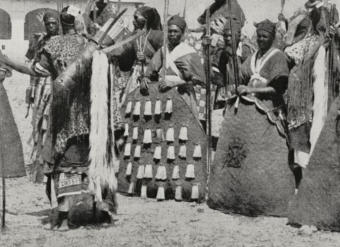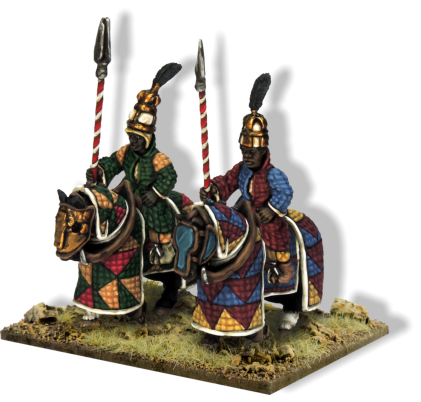






















DitDC armies
THE ARMIES OF REI BOUBA
THE "SILENT CITY"
Modibbo
The first overlord of Rei Bouba was Modibbo
Adama, the first Emir of Yola (after whom the
region and people of Adamawa were apparently
named), who reigned from 1806 until 1848. Some
time early in his reign a man called Ardo Yajo
(whose family was originally from Mali) seized
power in Rei Bouba. It was his son Jidda who first
tried to break away from Yola and persuade the
Sultan of Sokoto to recognise him as an independent
Emir in his own right. The Sultan refused, and
Adama responded by attacking and occupying the
city of Rei. Jidda eventually drove him out and
pushed the Yola forces back into what is now
Nigeria, but although it was now effectively
autonomous, Rei Bouba continued to send a nominal
tribute in slaves to Yola until that Emirate was
conquered by the British in 1901. Jidda was
succeeded some time before 1872 by Buba Jirum,
who presided over a period of prosperity, and by the
end of the 19th century Rei Bouba had become one of
the three leading states of the Adamawa region.
The city of Rei Bouba can still be found on a
modern map under that name, south-east of Garoua
in the savannah country of northern Cameroon, not
far from the Chad border. The map, however, gives
no hint that this place was once a byword for
mystery, as remote and inaccessible as Timbuktu.
The people of Rei Bouba, who were known as the
Boubandjidda, were mainly of Fulani origin. The
Fulani were cattle herders, originally from Senegal,
who by the 18th century had spread across the
Western Sudan as far east as Darfur. By this time
they had adopted both the Muslim religion and the
cavalry tactics of the Hausa and other peoples with
whom they had mixed. At some time in the late 18th
century one group of Fulani advanced south of Lake
Chad, drove the inhabitants into the Mandara
Mountains, and established some sixty small
emirates in the upland region which was to become
known as Adamawa. The rulers of these mini states
were known by the title of “Lamidos”. They were
originally vassals of the Emir of Yola (just over the
border in present-day Nigeria), who was himself a
subject of the Emir of the great Hausa-Fulani
Emirate of Sokoto. In contrast to the situation further
north, where the Fulani devoted most of their
energies to fighting their fellow Muslims, those in
Adamawa regarded themselves as a sort of military
colony with the responsibility of guarding and
extending the frontiers of Islam, and they made little
effort to assimilate the pagan tribes, whom they
called “Kirdi”. Instead they subjected their
neighbours to continual slave raids, which according
to the elephant hunter “Karamoja” Bell were still
taking place after the First World War.
Bouba Gida
At the time of the German occupation of what
became their colony of Kamerun, the Lamido was a
notorious tyrant known as Bouba Gida, who had
allegedly murdered his own father and three of his
brothers in order to seize the throne. In fact there
were all sorts of stories about this mysterious
character; according to Bell he was the son of a
slave, who had started his own business as a slave
raider and had founded the present city of Rei Bouba
himself in a previously uninhabited spot. “The
whole organisation”, says Bell in a rather back-
handed tribute to the Lamido, “is an example of
what can be done by courage, energy, force of
character and extreme cunning allied to ferocity and
cruelty.” This remote area retained its independence
from European imperialism much longer than most
of Africa, but in 1899, as British, French and
German armies converged on the Lake Chad region,
extinguishing on the way the last of the independent
Fulani emirates, Rei Bouba finally fell under
German control.
By Chris Peers
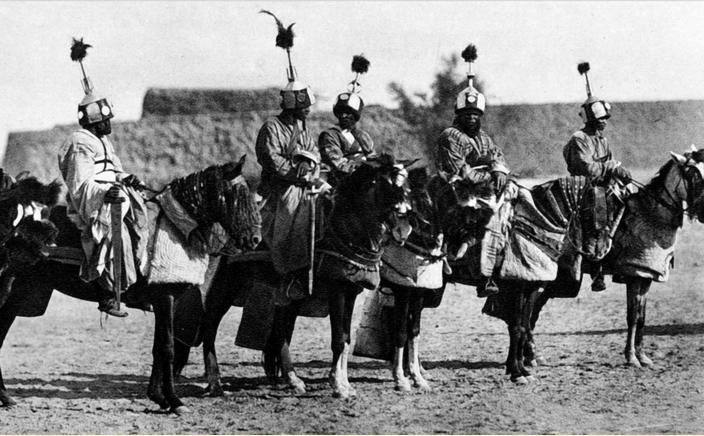
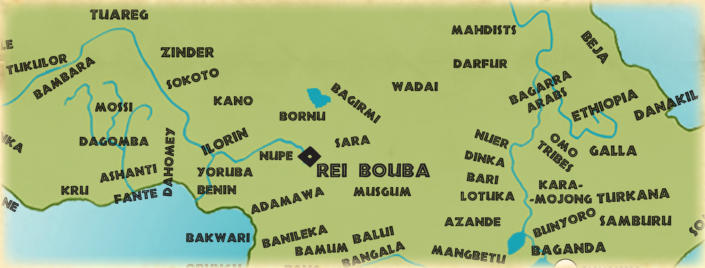
Map by the author showing positions of the tribes of Africa during this period, and showing the approximate
position of Rei Bouba: The "Silent City".
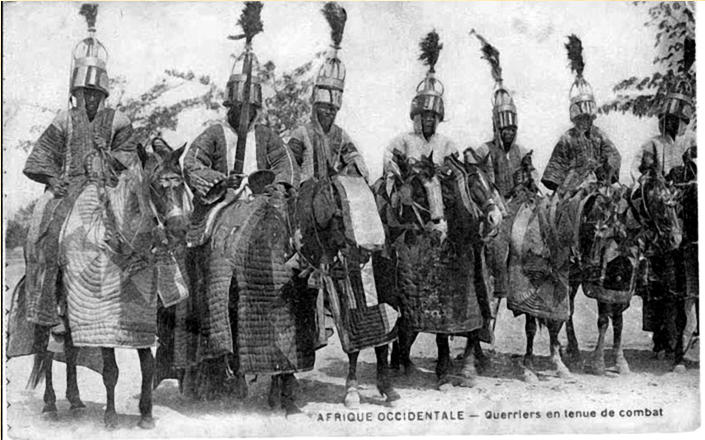
Lamido
However the new colonial authorities, impressed by
the good order maintained by the Lamido (and no
doubt by his “ferocity and cruelty”, which fitted in
perfectly with German ideas of how a colony should
be run), allowed him to retain his autonomy in
internal affairs, and perhaps for this reason the
conquest was carried out peacefully. When the First
World War broke out Bouba Gida provided men and
supplies for the German armies, but in early 1916,
when British and French forces were closing in on
the last German defenders of northern Kamerun, he
changed sides. After the war the French took over
this part of the country (which now became known
as Cameroun), and reaffirmed the autonomy of his
state as a reward for the Lamido’s timely assistance.
So it appears that it was principally due to the skill
and cunning of old Bouba Gida that Rei Bouba,
alone of the Adamawa emirates, survived into the
middle of the 20th century. Even after the Second
World War it remained what Bell calls “a remarkable
relic of the old slave-dealing days”, and one of the
very few places in colonial Africa “where a white
man’s actions are governed by a black man’s
wishes”.
Bouba Amadou
There were no European administrators in the
country, and even explorers and tourists were mostly
discouraged. Two well known British big-game
hunters, Major P. H. G. Powell-Cotton and Fred
Merfield, were allowed to visit Rei Bouba in the
early years of the 20th century in search of a rare
antelope, the giant eland (which they failed to find).
And shortly after the Second World War an Austrian
hunter, Ernst Zwilling, turned up to find the Sultan
still in power and his medieval army still on show.
Both Bouba Gida and his successor Bouba Amadou
obviously relished their position, and enjoyed
impressing their rare white visitors with their power
and authority. All three of our sources describe a
similar theatrical welcome. At the border they were
met by a sort of guard of honour, which conducted
them to the capital, and was joined along the way by
one contingent after another until they were being
escorted by a small army. The most spectacular
element of this army was the heavy cavalry -
equipped in Hausa-Fulani style with mail or quilted
armour for both riders and horses - who saluted their
visitors with ferocious mock charges. The city of Rei
Bouba itself was surrounded by a wall of mud brick
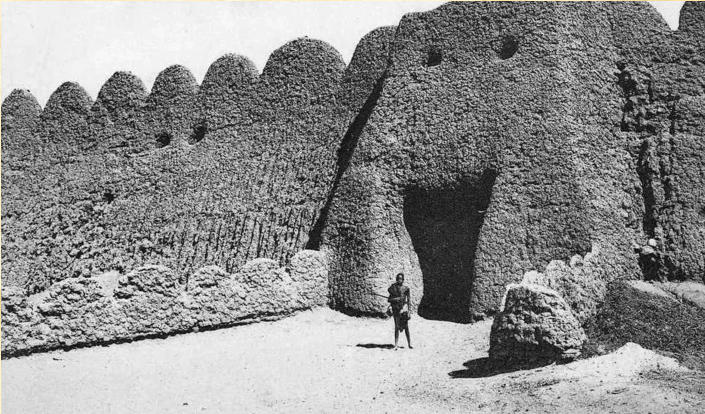
20 feet high, with massive wooden gateways flanked
by guard houses set into the walls, which at these
points were 50 feet thick. The royal palace was
situated within an even stronger inner citadel,
enclosed by walls 40 or 50 feet in height. The
Lamido was certainly an odd character, who
occasionally allowed white visitors into his territory
and even paraded his army to impress them, but
scarcely deigned to speak to them himself, or to
allow his subjects to do so any more than was
absolutely necessary. Merfield’s experience was
particularly spooky, as he found the city completely
silent - apart from the muezzins’ calls to prayer - and
the streets deserted. No one was to be seen except
for the soldiers who provided the visitors’ guard of
honour and a handful of servants delegated to look
after them. Whether the “silent city”, as Merfield
calls it, was always like that, or whether the Sultan
had arranged it to impress his guests, is not clear, but
Bell confirms that singing, shouting and laughing
aloud were banned, as were music, costly dress and
ornamentation (except apparently among the
soldiers), and - inevitably - the drinking of alcohol.
Even inside the city the buildings were just ordinary
grass and wattle huts, as anything more ostentatious
was likewise forbidden. Another of the Lamido’s
eccentricities was his pet lion, which was led about
on a chain by one of his servants. As the lion was not
actually tame but was well known for his bad
temper, this was not exactly a popular job and staff
turnover was high. In fact Merfield was told that the
post was reserved for people who had upset the boss,
as an alternative to using the official executioner.
Costume
The “costume of the country”, says Zwilling, was a
short blue tunic, but men of substance were usually
dressed in one or more voluminous “tobes” of
various colours. A “tobe” was basically a huge
baggy shirt, usually but not always worn over
trousers. In one passage Zwilling mentions “lancers
in red tobes”, in another an officer in “blue and red
silk robes”, and elsewhere red fezzes and blue
“Phrygian caps”. The cavalry (and, Zwilling implies,
many of the infantry) wore iron helmets decorated
with ostrich plumes.
Merfield describes the armoured cavalry thus:
“Their horses were canopied with cloth of crude designs
and brilliant colours, covering the animals to their ears
and reaching down almost to their fetlocks. Some of
the riders wore mail, others were swathed in heavy robes,
with colourful, plumed headgear, and they all carried
spears with blades two feet long.”
Horse
Zwilling mentions horse caparisons in “a variety of
patterns - blue and white triangles or squares”. Both
he and Bell took black and white photographs
showing this horse armour patterned with checks (by
far the most common) or vertical stripes, in what
appear to be white and one or two other colours.
Zwilling also saw cavalrymen being followed by
pages on foot, who carried a reserve supply of
throwing spears. Merfield goes on to remark that
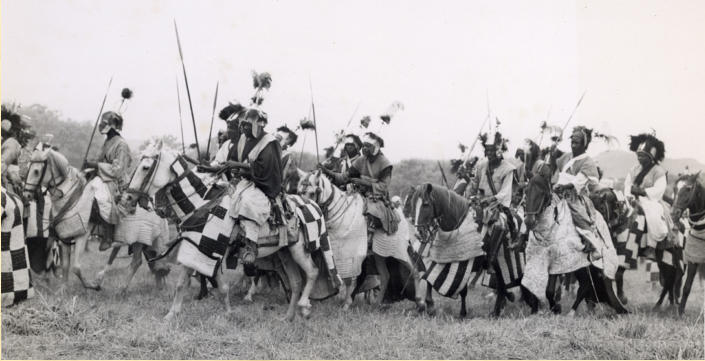
“they rode magnificently and had an uncanny
command of their horses”. The latter, Bell says, were
all stallions, which was general Hausa-Fulani
practice. According to Zwilling they were smallish
but well bred Arab-Berber steeds, whose daily ration
included half a calabash of beer (the animals being
presumably exempt from the religious ban on
alchohol). This contributed to their shining coats but
may not have done much for their fitness! It is
noteworthy that although these heavy cavalry were
typical of those found in the armies of the Fulani and
Hausa Emirates of the Western Sudan, none of our
sources mention the light cavalry which were
invariably in a majority further north. Adamawa was
home to some of the Shuwa Arabs who provided
much of the light cavalry for other Fulani armies,
and Rei Bouba was not far from the land of the
Musgum, who fought as light horsemen armed with
throwing knives. Therefore it seems likely that in the
days when Boubandjidda forces took the field in
earnest, rather than just to show off to visitors, they
would have been accompanied by at least some such
troops.
Infantry
The infantry were mainly spearmen and archers,
clad in tunics (presumably mostly blue), with
leopard skins draped over their shoulders. One of
Bell’s photographs shows a group of “commanders
of regiments” on foot, wearing what appear to be
long, elaborately decorated kilts. A rather crude
drawing from the same source depicts an archer in
what looks like a sleeveless shirt made of leopard
skin, and a plain knee-length kilt with trousers
underneath. He wears a fez on his head and a wide
sash or cummerbund round his waist, and has a
quiver slung on his back. His feet are apparently
bare. The spearmen had large shields made of
buffalo, rhinoceros or elephant hide which covered
most of their bodies, and the archers carried quivers
full of poisoned arrows on their backs. The guards
who escorted Merfield into the city carried an
assortment of “swords, axes, spears and
knobkerries”. Zwilling also mentions men armed
with “jagged” throwing knives. Though these
weapons were traditionally despised by the Fulani,
they were in practice carried even by Muslims, and
were especially popular among the non-Muslim
tribes of eastern Cameroun. In Zwilling’s time the
old Lamido’s successor, Bouba Amadou, had a
bodyguard of 50 men armed with guns of various
types and calibres (though the French authorities had
forbidden travellers to supply him with
ammunition), but this was probably a fairly recent
development. Most 19th century Fulani armies
obtained their firearms via the Sahara trade routes,
but these were a very long way from Rei Bouba.
Drums
Drums and trumpets accompanied all the military
exercises witnessed by the visitors, and no doubt had
done so in the field in the old days, as they did in
Fulani forces generally. Flags are not mentioned,
though they presumably existed and may have
resembled the ones carried by the armies of Sokoto;
these were white or blue, sometimes horizontally
striped, and occasionally carried inscriptions in
Arabic. One Bubandjidda nobleman was
accompanied by a servant with a red and white
striped parasol. It appears that by the early 20th
century the Lamido did not command his armies in
person on the slave raids which they still unofficially
conducted, but delegated the job to a subordinate,
who may himself have been a slave, or even a
eunuch. (Actually, according to Bell everyone in the
kingdom was technically a slave of the Lamido.)
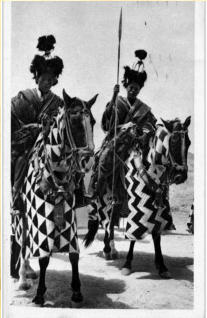
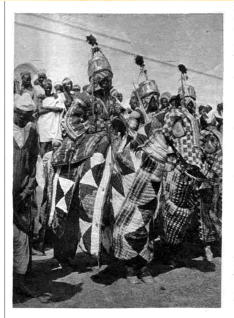
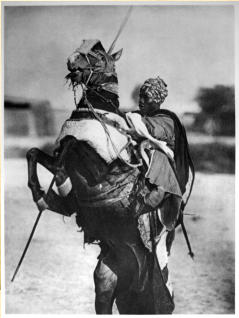
The Wargames Army
82. REI BOUBA, 1890-1899.
The late 19th century army of Rei Bouba is one of the options covered by army list number 10 in my “Death
In The Dark Continent” rules, “The Hausa-Fulani Emirates”. The list below is, however, more specifically
focused on the “silent city” under the rule of Bouba Gida, and includes a couple of new features designed to
bring out its peculiar character.
•
Ag 1, Disciplined if the Chief is Bouba Gida, otherwise Organised.
•
Yan lifida: Protected Heavy Cavalry with close combat weapons only (10 points)
1–2
•
Shuwa Arab cavalry: Light Horse with spears (7 points)
0–1
•
Musgum cavalry: Light Horse with throwing knives (9 points)
0–1
•
Yam baka: Skirmishers with spears or bows (4 points), or throwing knives (6 points)
1–6
•
Guardsmen: Warriors (6 points) or Elite Skirmishers (8 points) with spears
0–1
Notes
A Chief representing Bouba Gida (1890 – 1899) may be Outstanding.
Any or all Heavy Cavalry may be upgraded to to Elite (+4 points).
Home terrain is Savannah.
Defences: Town walls, Tembes.
Stratagems: Drums.
Special Rule: Lion! We have no evidence that Bouba Gida’s pet lion actually accompanied the army into
battle, but we can speculate that it might have had an adverse effect on an enemy if it had done. So if the
Chief is Bouba Gida he can be accompanied by a base representing a lion being held on a chain by a slave,
which costs 20 points. The beast will not actually be let loose to fight, but the horses of enemy cavalry do not
know this, and the sound and smell of it may cause them to panic. So any opposing mounted unit which is
within 12 inches of the lion in the morale phase of a turn must take 2 morale tests for this cause. The lion
moves at normal Skirmisher rate and is shot at as if it was a single base Skirmisher unit. It cannot be moved
into close combat, but if an enemy contacts it it fights like an Elite Warrior base. It never needs to take morale
tests itself, though if it is killed friendly units need to test as usual for seeing a unit destroyed.
Sources:
W. D. M. Bell, “The Wanderings of an Elephant Hunter”.
London, 1923.
S. J. Hogben, “An Introduction to the History of the
Islamic states of Northern Nigeria”. Ibadan, 1967.
F. G. Merfield, “Gorillas Were My Neighbours”. London,
1957.
E. A. Zwilling, “Jungle Fever”. London, 1956.
